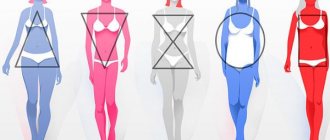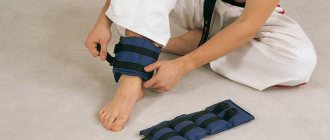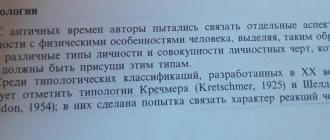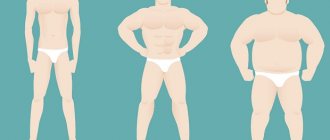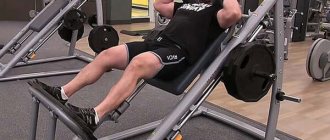Why do some people eat everything and don’t get fat, while others can get sick just from the smell of fresh baked goods? Why can some people become the second Schwarzenegger in almost a year, while others have been going to the gym for several years in a row, and their shape remains the same. The fact is that each person belongs to a certain body type (somatotype). There are three of them: ectomorph, mesomorph, endomorph.
The training and nutrition program for each body type should be radically different due to the characteristics of the figure, metabolic rate and training strategy (number of approaches / repetitions / rest periods). Of course, there are many other factors that influence the final result, but genetics still decides.
So, in order to properly build a training program and create a diet, we must correctly identify ourselves and determine our body type.
Wrist measurement
It is necessary to measure your wrist at the narrowest point with a centimeter tape and compare it with the data in the table.
| Body type (somatotype) | Wrist circumference (men) | Wrist circumference (women) |
| Ectomorph | less than 18 cm | less than 15 cm |
| Mesomorph | from 18 to 20 | from 15 to 17 |
| Endomorph | from 20 and more | from 17 and over |
This method is the simplest, but its accuracy is very relative and today, some studies generally question the possibility of determining the somatotype using such parameters.
What somatotypes are there?
The theory of somatotypes was described in most detail in 1940 by the American physician William Sheldon. “According to this system, all people are divided according to morphological characteristics into endomorphs, mesomorphs and ectomorphs. Sheldon used measures on a seven-section scale. Depending on the predominance of one or another component, these were the following body types: ectomorph (thin and tall), mesomorph (with a predominance of bones and muscles), endomorph (rounded, with excess fat),” adds Ekaterina Kalinina.
Pure body types are rare, but every person has a certain dominant somatotype. Let's take a closer look at them.
Ectomorph
Another name is asthenic. “People of this type are distinguished by a predominance of longitudinal dimensions, have relatively long limbs, poorly developed muscles, a thin layer of subcutaneous fat and narrow bones,” explains Ekaterina Zhuravleva.
Ectomorphs have a nervous system with increased activity. “These people have an innately fast metabolism, the level of subcutaneous fat is low, so men of this type are not inclined to bodybuilding. If other people easily gain weight with poor nutrition, then until the age of 40, an ectomorph can eat pizza, drink sweet soda and not gain a single gram of fat,” recalls Ekaterina Kalinina.
How to train? It is difficult for such people to gain weight and build muscle mass, but this is what they need. It is extremely important for “fragile” ectomorphs to strengthen their muscle corset, otherwise pain in the back and joints is inevitable, adds Ekaterina Zhuravleva. “To gain muscle mass, they need to take care of their diet and choose the right workout program in the gym.”
It is optimal, of course, to train according to a program compiled for you by a fitness mentor. Is there no such possibility? Try this training plan.
Mesomorph
Or a normosthenic is an “average” person: the length of his limbs and height are average. He gains weight quite easily, but can lose it without much difficulty. “A pure mesomorph is the owner of a strong body with well-defined muscle relief. He has broad shoulders and chest, muscular arms and legs. The amount of subcutaneous fat is minimal. Mesomorphs gain and lose weight relatively easily,” notes Ekaterina Zhuravleva.
How to train. It all depends on your goal. “Strong, active and hardy mesomorphs should first decide on their goal: gaining muscle mass, maintaining body tone, developing endurance, losing weight. The lesson program will depend on this, says Ekaterina Zhuravleva. — If you need to build muscles, then this is strength training; light cardio exercises, swimming, and various types of group training are perfect for tone. Mesomorphs are the lucky ones: they require much less effort to achieve any result.”
Try this ready-made training program for mesomorphs.
Endomorphs
Or hypersthenics. They are usually not tall and have excess fat mass. “The body of classic endomorphs is characterized by a massive bone structure, wide waist and excess fat deposition. Metabolism in endomorphs is slow, strength indicators are low, says Ekaterina Kalinina. — It is believed that the endomorph is the most common body type among European nations. An endomorph's figure is often spherical or pear-shaped because their pelvis is wider than their shoulders. The limbs can be relatively short or, which is less common, long. The head is most often large.”
Endomorphs tend to be overweight and, as a rule, do not like sports and any types of activities.
How to train. “Endomorphs who are prone to obesity, first of all, should be careful about nutrition, otherwise all the efforts in the gym may be in vain,” recalls Ekaterina Zhuravleva. — To minimize the amount of body fat, all training methods should be aimed at accelerating metabolism, which is naturally low in endomorphs. This is possible thanks to cardio and strength training. At the same time, outside the fitness center, endomorphs should also be active: walk more, not use the elevator, etc.”
An example of a ready-made program for endomorphs can be found here.
Determination of the epigastric angle
The epigastric angle is the angle that forms between the 12th pair of ribs (the lowest pair). To determine it, go to the mirror, take a deep breath and hold your breath. Take two pencils and arrange them so that their ends on one side meet at the junction of the lower edges, and the pencils themselves are located along each of the edges. The location of the pencils will clearly show you the size of the intercostal angle. By its value you can determine your body type.
| Body type (somatotype) | The value of the epigastric angle ° |
| Ectomorph | less than 90° |
| Mesomorph | 90° |
| Endomorph | more than 90° |
Training for mesomorph:
Frequency/periodization:
- The body of those who are mesomorphs responds well to basic weight-bearing exercises.
- The more varied the training program, the better the result.
- Alternate 3-4 weeks of high-intensity training with a couple of weeks of low-intensity training. This will help you gain muscle mass, increase strength, and combat muscle burn.
Sets and reps:
- Quick, basic resistance exercises and then progress to isolation exercises.
- For most muscle groups, perform 8-12 reps per set.
- For quads, hamstrings, and calves, alternate reps from 6 to 25.
- Be careful not to overexert yourself in hopes that it will speed up growth, due to the natural genetic advantage
Intensity:
- Don't let your body get used to it, constantly vary the intensity of your workout, exercises, number of approaches, repetitions, weights and rest time.
- Make sure your training program includes easy, hard, and moderate days.
- Combine a moderate pace with fast repetitions.
- Constantly vary the intensity of your workout: partial reps, forced reps, descending sets, compound sets, pre-exhaustion.
Recovery:
- Without proper rest, your genetic advantage can never be fully utilized.
- Try to get 7.5-9 hours of sleep every night.
- Never exercise body parts that have not yet fully recovered.
- If you feel a lack of motivation, energy and strength, rest another day.
Aerobic load:
- For maximum muscle growth, cut down on your cardio. No more than three times a week, 20-30 minutes each (5 minutes warm-up, 15-20 minutes maintaining target heart rate, 5 minutes cool-down).
- Try to keep your target heart rate at an average level.
- Recommended activity: Stair climbing, treadmill, vigorous walking and exercise bike.
- If you love running, run no more than 1.5-2 kilometers, three times a week. At the same time, avoid any other aerobic activity.
- Many mesomorphs note that performing aerobic exercise also promotes leg growth.
Nutrition:
- The daily protein intake is at least 2 grams per kilogram of weight.
- Keep your carbohydrate intake fairly high, around 60% of your total calories; Opt for vegetables, brown rice, lean beans, lentils and whole grains.
- Limit the amount of fat, no more than 15-20%.
- Eat plenty of lean protein, found in chicken, turkey, egg whites, lean beef and fish.
Lifestyle:
- Don't try to do too much in a short period of time. This approach can lead to injury, overtraining, and burning muscles.
- Take your time, learn to listen to your body.
- Be patient but persistent.
- Drink at least 2.5 liters of water per day.
Female body types according to Sheldon.
A-shaped body type:
- the shoulders are narrow, the pelvis is much wider;
- impression of a “heavy” lower body – full legs and buttocks;
- tendency to store fat below the waist (the upper body may even appear thin);
- low metabolic rate (if you don’t specifically follow your diet, weight gains quickly).
* In everyday classification this corresponds to a “pear” or triangle shape
H-shaped body type:
- wide or medium bone;
- small breasts;
- visual impression of approximately the same width of shoulders, waist and pelvis;
- tendency to form fat deposits in the abdomen and thighs;
- moderate metabolic rate.
* In everyday classification, this corresponds to a “rectangle” type figure.
I-shaped body type:
- thin bones;
- gauntness;
- weak muscles;
- almost no fat deposits;
- high metabolic rate (no matter how much you eat, you don’t get fat).
O-shaped body type:
- wide bones;
- wide pelvis and shoulders;
- full hips, chest, arms;
- obvious excess fat deposits throughout the body;
- low metabolism (weight comes on even if you eat relatively little).
*In everyday classification this corresponds to an “apple” type figure
T-shaped body type:
- broad shoulders, wider than the pelvis;
- fat is deposited mainly on the torso (back, chest, sides);
- average metabolic rate (you only gain weight if you start eating too much).
X-shaped body type
- medium bones;
- The width of the shoulders is approximately equal to the width of the hips;
- slim waist;
- full breasts;
- fat deposits form on the buttocks and thighs;
- average metabolic rate (weight gain due to excessive eating).
*In everyday classification this corresponds to the hourglass figure.
Endomorphic body type
The endomorphic or hypersthenic type usually has rounded shapes, wide bones, short massive limbs, wide hips and waist, as well as a high percentage of adipose tissue. This somatotype is one of the most common.
To give and maintain definition, endomorphs are recommended to adhere to a high-protein diet (40-50% of the daily diet), with the complete exclusion of simple sugars and flour products, with moderate consumption of carbohydrates (25-35%).
Training should be done on a regular basis with a predominance of basic exercises to speed up metabolism and cardio loads. Preferred trainings are split systems “2+1” or “3+1”.



